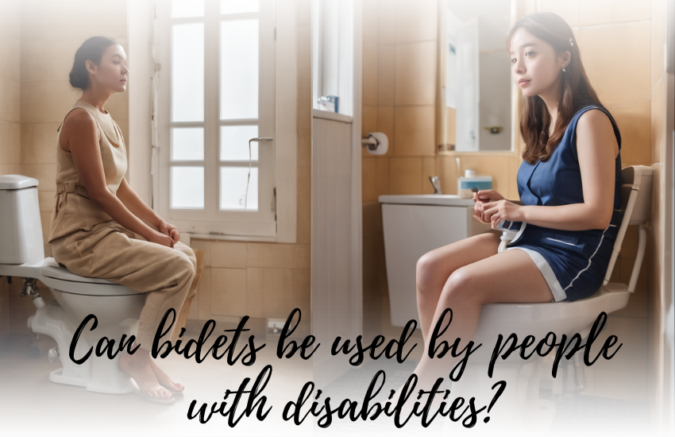Introduction:
The evolution of bidets from luxurious additions to fundamental bathroom fixtures has brought forth a paradigm shift. No longer just associated with hygiene and environmental benefits, bidets have emerged as champions of inclusivity, significantly impacting on the lives of individual people who is suffering with disabilities.
Within conventional bathroom designs that heavily lean on toilet paper for personal hygiene, a significant obstacle emerges for individuals with disabilities. This reliance poses formidable challenges, impeding both independence and effective hygiene management for those with limited mobility or physical impairments.
Advantages of Bidets for People with Disabilities:
- Promoting Independence and Personal Hygiene:
Bidet, equipped with adjustable features such as water temperature and pressure, become empowering tools. They allow individuals to autonomously manage their hygiene, thereby reinstating a sense of dignity and control.
- Beneficial for Mobility-Impaired Individuals:
Bidets ease discomfort for those with conditions like arthritis, multiple sclerosis, or spinal cord injuries by reducing physical strain during toileting.
- Inclusive Design Features:
Customisable settings, remote controls, illuminated panels, and accessible height adjustments cater to diverse needs, ensuring inclusivity.
What are the Environmental Impact and Sustainability Bidet bring?
Bidets presents a sustainable solution by significantly reducing toilet paper usage, aligning with global efforts towards environmental preservation. This reduction not only lessens the environmental impact associated with paper production and disposal but also addresses challenges faced by individuals with disabilities in managing traditional paper-based hygiene methods. By opting for bidets, users contribute to the reduction of deforestation, water consumption, and waste generation linked to toilet paper. Simultaneously, for individuals with disabilities, bidets offer a more comfortable and accessible means of personal hygiene, minimising physical strain and enhancing independence. This dual benefit of promoting sustainability while catering to diverse accessibility needs marks bidets as an eco-friendly and inclusive solution in personal hygiene practices.
How can bidet integration and awareness be improved for individuals with disabilities?
- Accessibility Guidelines Adherence:
Ensuring that bidet installations comply with established accessibility standards and guidelines is paramount. This includes considerations for height adjustments, easy-to-reach controls, and clear instructions for operation. By meeting these standards, bidets become more inclusive and usable for individuals with diverse needs.
- Customisable Installations:
Designing installations that cater to a variety of preferences and requirements is essential. Offering a range of bidet models with different features (adjustable water temperature, pressure, nozzle positioning) ensures inclusivity by accommodating various disabilities and personal preferences.
- Education and Outreach:
Educating caregivers, healthcare providers, and the general public about the advantages and functionality of bidets is key to fostering acceptance and integration. Workshops, informational materials, and awareness campaigns can effectively communicate the benefits of bidets in enhancing independence and hygiene for individuals with disabilities.
- Incorporating Bidets in Public Spaces:
Including bidets in public facilities, such as hospitals, airports, and accessible restrooms, demonstrates a commitment to inclusivity. Making bidets readily available in these spaces normalises their use and ensures that individuals with disabilities can access them outside their homes.
- Collaboration with Disability Advocacy Groups:
Partnering with disability advocacy organisations allows for valuable insights into the specific needs and preferences of individuals with disabilities. Collaborative efforts can guide the design and implementation of bidet installations that truly cater to diverse user requirements.
Conclusion: Bidets for People with Disabilities
Bidets serve as a transformative solution, revolutionising the landscape of inclusive hygiene practices, especially for individuals with disabilities. Their adaptable design, featuring user-friendly controls and tailored functionalities, marks a significant step forward in providing unparalleled independence and comfort. By seamlessly integrating bidets into accessible facilities, we affirm our dedication to creating spaces that prioritise the diverse needs of every individual. This commitment extends beyond mere convenience, encapsulating a profound ethos of inclusivity, ensuring that no one is left behind in experiencing the dignity and ease that bidets bring to personal hygiene.
Embracing bidets as fundamental fixtures within these environments isn’t just about accommodating specific needs; it’s about fostering a culture of understanding and support. It reflects our united efforts to prioritize accessibility as a fundamental element, ensuring everyone, regardless of ability, feels empowered and included in our environments.
FAQs:
Bidets are highly suitable for individuals with limited mobility. They offer customisable features such as adjustable water temperature, pressure, and nozzle positioning, making them easily accessible and empowering users to manage their hygiene independently.
Absolutely. Bidets cut toilet paper use, aiding sustainability globally. This not only helps the environment but also eases challenges for people with disabilities managing traditional hygiene methods.
Yes, bidets are designed with inclusive features to cater to diverse needs. They offer various settings and models with customisable functionalities, ensuring accommodation for different disabilities and individual preferences.
